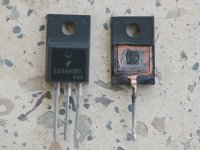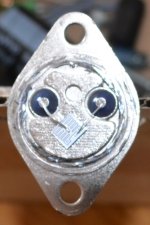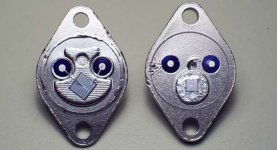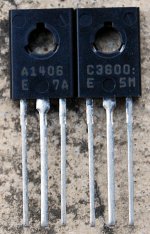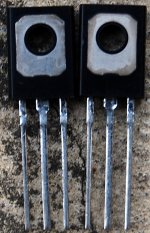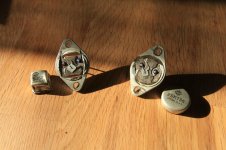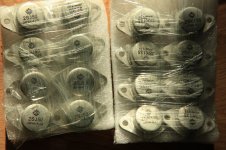Linear Systems make the LSK389 which is a current equivalent of the Toshiba part
No need for hand wringing about counterfeits
Correct. I'm waiting for samples. However, not available in the ZIP7 package but the TO-71 package will probably fit the lay-out of my Borbely power amp.
Anyone know if this is a genuine Motorola MJ15003 or a fake.
The simplest test is a breakdown test. I seem to remember the die being squared up on originals. It's been more than thirty years since I had one of those oped up. Something doesn't look right about that one.
I bought 2SC3600E / 2SA1406E pair from Japan (Wakamatsu). It doesn't look like tradition Sanyo transitor. So:
- Any one can tell if they are fake or real.
- Guide me through some tests to identify that?
First test is to put some acetone or lacquer thinner on a Qtip and see if you can remove the lettering. If they're fake the ink will likely come off. This test is not full prof.
Do some electrical tests.
First test is to put some acetone or lacquer thinner on a Qtip and see if you can remove the lettering. If they're fake the ink will likely come off. This test is not full prof.
Do some electrical tests.
Thanks!
I used Qtip with acetone with a little hard on the lettering but it still remains.
So electrical tests next. Which one do I need to test on this bjt?
Thanks!
I used Qtip with acetone with a little hard on the lettering but it still remains.
So electrical tests next. Which one do I need to test on this bjt?
I would do a breakdown test. There is some disagreement as to whether this should be done with the base open or shorted to emitter. You will need some form of current limiting. A 1k resistor will do. Insert a current probe into the circuit and you can test for leakage at the same time. For an NPN connect the emitter to ground and place the 1k resistor in series with the collector. Apply a positive voltage to the 1k resistor and vary the voltage from 0 to 10V greater than the collector breakdown voltage. Verify your transistor becomes a zener diode at the voltage the data sheet specifies. If it breaks down early then you have a fake. You might see smoke from the resistor.
I would do a breakdown test. There is some disagreement as to whether this should be done with the base open or shorted to emitter. You will need some form of current limiting. A 1k resistor will do. Insert a current probe into the circuit and you can test for leakage at the same time. For an NPN connect the emitter to ground and place the 1k resistor in series with the collector. Apply a positive voltage to the 1k resistor and vary the voltage from 0 to 10V greater than the collector breakdown voltage. Verify your transistor becomes a zener diode at the voltage the data sheet specifies. If it breaks down early then you have a fake. You might see smoke from the resistor.
I wouldn't leave the base open, tie it to GND. Seems more dangerous to leave base floating. It's best to do this on a curve tracer which will limit the power delivered to the DUT. I guess a series resistor will do. What's the max Vce spec? Also don't you want to check the beta? A crappy transistor will likely have a low beta.
Edit: just looked up specs. 200v Vceo and Vcbo. hFE 40 min at 10mA Ic. I would say you should measure beta in the 60 to 80 range. The collector breakdown should be > 200v (which could a bit difficult to test).
Last edited:
hfe ~ 170 -> ok since it is grade E (100 - 200).
And you are right, V collector breakdown > 200V means it is different to test for me.
I concern about this trans because Sanyo seem usually use print with white text, not laser print like of me. My friend have a pair of used 2SC3117/2SA1249 from Sanyo, look the text on body like this pic.
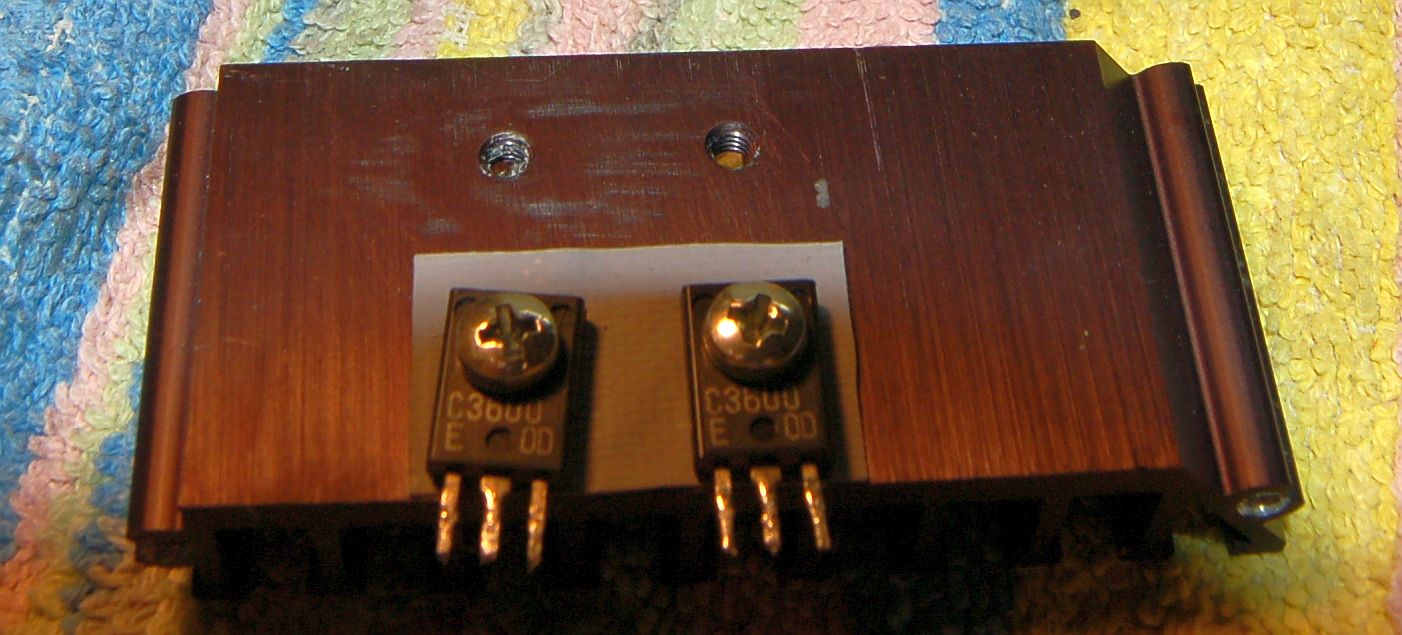
And you are right, V collector breakdown > 200V means it is different to test for me.
I concern about this trans because Sanyo seem usually use print with white text, not laser print like of me. My friend have a pair of used 2SC3117/2SA1249 from Sanyo, look the text on body like this pic.

For a test voltage of > 250Vdc, you will need a very much higher value current limit resistor.
Maybe 100k, to prevent destruction of the DUT, when it begins to avalanche.
Maybe 100k, to prevent destruction of the DUT, when it begins to avalanche.
Hi!
Are these real K135/J50?
They are from the ebay seller "polida2008".
Yes, they are Abused, tortured and tested hardly! They seem to be equal to the datasheet. But might be a renamed exicon perhaps?
Are these real K135/J50?
They are from the ebay seller "polida2008".
Yes, they are Abused, tortured and tested hardly! They seem to be equal to the datasheet. But might be a renamed exicon perhaps?
Attachments
Last edited:
Hi!
Are these real K135/J50?
They are from the ebay seller "polida2008".
Yes, they are Abused, tortured and tested hardly! They seem to be equal to the datasheet. But might be a renamed exicon perhaps?
What year is the date code on those? 4J2.
The print look authentic. Try removing it with lacquer thinner.
Yes. I have 4J2, 2A9, 9513 on the "2SJ50" and 3J1, 1022 on the "2SK135"
I tried with acetone and the 2SK135 doesn't loose it's painting. However if i rub hard enough some of the "2SJ50" loose it's painting, not much but it does.
I tried with acetone and the 2SK135 doesn't loose it's painting. However if i rub hard enough some of the "2SJ50" loose it's painting, not much but it does.
Yes. I have 4J2, 2A9, 9513 on the "2SJ50" and 3J1, 1022 on the "2SK135"
I tried with acetone and the 2SK135 doesn't loose it's painting. However if i rub hard enough some of the "2SJ50" loose it's painting, not much but it does.
It shouldn't. Try the thinner.
package is very prone to destroy the fets by ESD.
the unwrapping alone is risky.
try to squeeze alu foil through the pins, through the wrap. then cut stuff loose..
the unwrapping alone is risky.
try to squeeze alu foil through the pins, through the wrap. then cut stuff loose..
I know, that's the package i received them in! (not good at all)
The backplate is magnetic (like everything on these FETs) so i guess i's steel and not aluminium.
I tried with some "White spirit" and the markings stayed. I have no thinner :/
The backplate is magnetic (like everything on these FETs) so i guess i's steel and not aluminium.
I tried with some "White spirit" and the markings stayed. I have no thinner :/
- Home
- Design & Build
- Parts
- My Transistors, original or copy?
